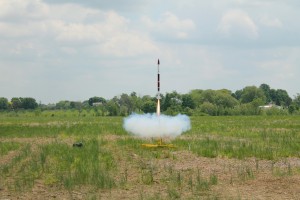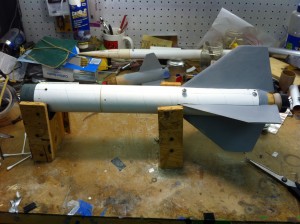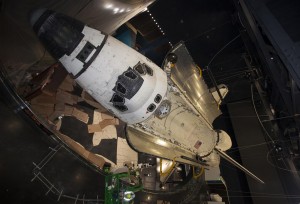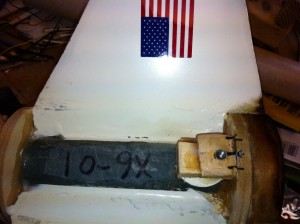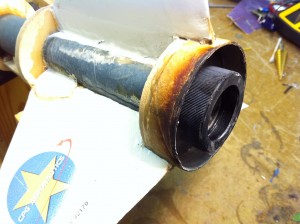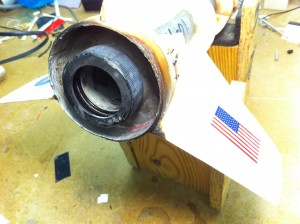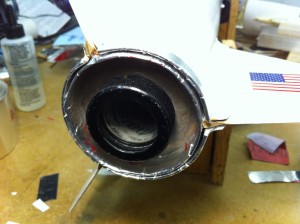(Cuyahoga Falls, OH – March 23, 2013)
After the unsuccessful “shakedown” maiden flight of Nesaru (Mission NAS-001), the first of what would become two
attempts to gain my NAR Level 1 High Power Rocketry certification was underway.
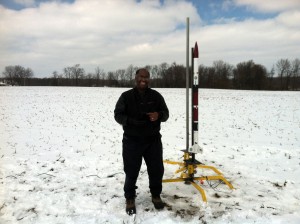
CG and the XR-6 Nesaru rocket just before mission NLS-003.
The failure mode of the shakedown / maiden voyage (ALS-001) was due to the effects of cold weather conditions on the alkaline
A-23 batteries used to power the electronics & ejection charges. Temperatures were in the lower 40’s that day.
On February 9, 2013, mission ALS-002 was poised to start with two goals.
1) to prove the Lithium Polymer battery system
in cold weather (temperatures that day were in the upper 20’s.)
2) Gain my NAR Level 1 certification.
I figured there would be no issues with goal #1 as Artemis / Nala1 just flew a very successful flight (ALS-051) on the same type of power system, reaching an altitude of 2052’…the highest altitude of any of my rockets to date.
Anyway, the launch was beautiful, powered with a Cessaroni H255 motor. The separation event happened on cue at the apogee of Nesaru’s flight (about 1740′).
At this point, he wait for the main parachute deployment began…we waited…and waited, and … no parachute deployment.
As a result, Nesaru suffered it’s second rough landing – completely breaking one of its fins from the resulting rough bounce on the ground.
Failure analysis showed a dumb-ass mistake on my part where an unused hole at the top of the electronics bay was not properly sealed off.
Because of this, when the deployment charge to separate the fairing containing the main parachute was detonated, the poor patch job gave way. When this happened, all of the pressure needed to break the nylon shear pin holding the fairing together vented through the air sensor holes. As a result, the fairing stayed together, and no parachute deployment.
On March 23rd, after all repairs were made, and some slight design tweaks made, attempt # 2 was underway. All systems were checked again, and one more time before prep work began for mission NLS-003. The total time spent in the cold checking and prepping Nesaru lasted nearly 3 1/2 hours, but it would prove to be worth it.
For this mission, I chose the Aerotech H-180 motor to power the flight.
The rocket roared to life with the beautiful bright white flame that I love so much in the Aerotech White lighting propellant, and Nesaru flew to a little over 900 feet.
Again, the apogee event happened right on time, and this time – at 500′ above the ground, the main parachute successfully deployed!
Nesaru landed safely with no recovery damage! At this moment, I earned my level 1 certification!
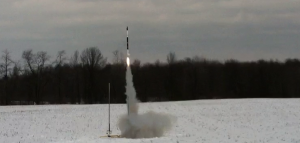
Liftoff! Mission NLS-003 begins!
NLS-003 was a much slower flight than the first two, reaching a peak velocity of 240 MPH, proving that the design can remain stable at more “conventional” speeds. NLS-001, and NLS-002 topped out at 560 MPH (Mach .75).
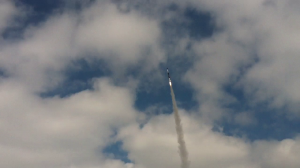
With a satisfying roar, Nesaru reaches for the sky!
NLS-003 was intentionally kept at a much lower altitude and also made use of a “drogue” parachute to minimize damage to the airframe should another “main parachute” malfunction event happen. The drogue parachute will
remain in use for the next few flights of Nesaru.
NLS-004 is scheduled for April 28, 2013 (weather permitting). She will once again fly on an Aerotech H-180, and the goal of the next mission is to reach the full peak altitude, which i sexpected to be close to 2000 feet.
The NLS-003 post-flight analysis post will be here on the site in a few days…
((( )))
